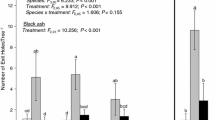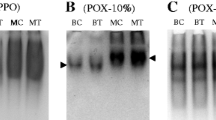Abstract
We examined the extent to which three Fraxinus cultivars and a wild population that vary in their resistance to Emerald Ash Borer (EAB) could be differentiated on the basis of a suite of constitutive chemical defense traits in phloem extracts. The EAB-resistant Manchurian ash (F. mandshurica, cv. Mancana) was characterized by having a rapid rate of wound browning, a high soluble protein concentration, low trypsin inhibitor activities, and intermediate levels of peroxidase activity and total soluble phenolic concentration. The EAB-susceptible white ash (F. americana, cv. Autumn Purple) was characterized by a slow wound browning rate and low levels of peroxidase activity and total soluble phenolic concentrations. An EAB-susceptible green ash cultivar (F. pennsylvanica, cv. Patmore) and a wild accession were similar to each other on the basis of several chemical defense traits, and were characterized by high activities of peroxidase and trypsin inhibitor, a high total soluble phenolic concentration, and an intermediate rate of wound browning. Lignin concentration and polyphenol oxidase activities did not differentiate resistant and susceptible species. Of 33 phenolic compounds separated by HPLC and meeting a minimum criterion for analysis, nine were unique to Manchurian ash, five were shared among all species, and four were found in North American ashes and not in the Manchurian ash. Principal components analysis revealed clear separations between Manchurian, white, and green ashes on the basis of all phenolics, as well as clear separations on the basis of quantities of phenolics that all species shared. Variation in some of these constitutive chemical defense traits may contribute to variation in resistance to EAB in these species.



Similar content being viewed by others
References
Appel, H.M. 1993. Phenolics in ecological interactions: the importance of oxidation. J. Chem. Ecol. 19:1521Y1552.
Bonello, P. and Pearce, R. 1993. Biochemical defense responses in primary roots of Scots pine challenged in vitro with Cylindrocarpon destructans. Plant Pathol. 42:203Y211.
Bonello, P., Heller, W., and Sanderman, H.J. 1993. Ozone effects on root-disease susceptibility and defence responses in mycorrhizal and non-mycorrhizal seedlings of Scots pine (Pinus sylvestris L.). New Phytol. 124:653Y663.
Bradford, M.M. 1976. A rapid and sensitive method for the quantitation of microgram quantities of protein utilizing the principle of protein-dye binding. Anal. Biochem. 72:248Y254.
Buschmann, H., Rodriguez, M.X., Tohme, J., and Beeching, J.R. 2000. Accumulation of hydroxycoumarins during post-harvest deterioration of tuberous roots of cassava (Manihot esculenta Crantz). Ann. Bot. 86:1153Y1160.
Cabral, M.M.O., Kelecom, A., and Garcia, E.S. 1999. Effects of the lignan, pinoresinol on the moulting cycle of the bloodsucking bug Rhodnius prolixus and of the milkweed bug Oncopeltus fasciatus. Fitoterapia 70:561Y567.
Cipollini, D.F. and Redman, A.M. 1999. Age-dependent effects of jasmonic acid treatment and wind exposure on foliar oxidase activity and insect resistance in tomato. J. Chem. Ecol. 25:271Y281.
Cipollini, D.F., Enright, S., Traw, B., and Bergelson, J. 2004. Salicylic acid inhibits jasmonic acid-induced resistance of Arabidopsis thaliana to Spodoptera exigua. Mol. Ecol. 13:1643Y1653.
Cis, J., Nowak, G., and Kisiel, W. 2006. Antifeedant properties and chemotaxonomic implications of sesquiterpene lactones and syringin from Rhaponticum pulchrum. Biochem. Syst. Ecol. 34:862Y867.
Chen, Y, Whitehill, J.G.A., Bonello, P., and Poland, T.M. 2011. Differential response in foliar chemistry of three ash species to Emerald Ash Borer adult feeding. J. Chem. Ecol. 37:29Y39.
Cheng, G.W. and Crisosto, C. 1995. Browning potential, phenolic composition, and polyphenoloxidase activity of buffer extracts of peach and nectarine skin tissue. J. Amer. Soc. Hort. Sci. 120:835Y838.
Dehon, L., Macheix, J.J., and Durand, M. Involvement of peroxidases in the formation of the brown coloration of heartwood in Juglans nigra. J.Exp. Bot.53:303Y311.
Deiana, M., Incani, A., Corona, G., Atzeri, A., Loru, D., Melis, M.P., and Dessi, M. 2008. Protective effect of hydroxytyrosol and its metabolite homovanillic alcohol on H2O2 induced lipid peroxidation in renal tubular epithelial cells. Food Chem.Toxicol. 46: 2984–2990.
Doledec, S. and Chessel, D. 1987. Rythmes saisonniers et composantes stationnelles en milieu aquatique I—Description d'un plan d'observations complet par projection de variables. Acta Oecol., Oecol. Generalis 8:403Y426.
Dowd, P. F. and Norton, R.A. 1995. Browning-associated mechanisms of resistance to insects in corn callus tissue. J. Chem. Ecol. 5:583Y600.
Dray, S. and Dufour, A.B. 2007. The ade4 package: implementing the duality diagram for ecologists. J. Stat. Softw. 22:1Y20
Dunn, J.P., Potter, D.A., and Kimmerer, T.W. 1990. Carbohydrate reserves, radial growth, and mechanisms of resistance of oak trees to phloem boring insects. Oecologia 83:458Y468.
Eyles, A., William, J., Riedl, K., Cipollini, D., Schwartz, S., Chan, K., Herms, D.A., and Bonello, P. 2007. Comparative phloem chemistry of Manchurian (Fraxinus mandshurica) and Two North American Ash species (Fraxinus americana and Fraxinus pennsylvanica). J. Chem. Ecol. 33:1430Y1448.
Felton, G.W., Donato, K., Delvecchio, R.J., and Duffey, S. 1989. Activation of plant foliar oxidases by insect feeding reduces nutritive quality of foliage for noctuid herbivores. J. Chem. Ecol. 15:2667Y2694.
Garcia, E.S., Cabral, M.M.O., Schaub, G.A., Gottlieb, O.R., and Azambuja, P. 2000. Effects of lignoids on a hematophagous bug, Rhodnius prolixus: feeding, ecdysis, and dieresis. Phytochemistry 55:611Y616.
Gould, J., Tanner, J. Winograd, T.D., and Lane, S. 2005. Initial studies on the laboratory rearing of emerald ash borer and foreign exploration for natural enemies, pp. 73Y74, in V. Mastro and R. Reardon (eds.). Emerald Ash Borer Research and Technology Development Meeting. U.S. Department of Agriculture, Forest Service, Morgantown, West Virginia.
Kehr, J. 2006. Phloem sap proteins: their identities and potential roles in the interaction between plants and phloem-feeding insects. J. Exp. Bot. 57:767Y774.
Levin, D. 1976. The chemical defenses of plants to pathogens and herbivores. Annu. Rev. Ecol. Syst. 7:121Y159.
Liu, H.P., Bauer, L.S., Miller, D.L., Zhao, T.H., Gao, R.T., Song, L.W., Luan, Q.S., Jin, R.Z., and Gao, C.Q. 2007. Seasonal abundance of Agrilus planipennis (Coleoptera: Buprestidae) and its natural enemies Oobius agrili (Hymenoptera: Encyrtidae) and Tetrastichus planipennisi (Hymenoptera: Eulophidae) in China. Biol. Control. 42:61Y71.
Mittapalli, O., Bai, X. Mamidala, P., Rajarapu, S.P., Bonello, P., and Herms, D.A. 2010. Tissue-tissue specific transcriptomics of the exotic invasive insect pest, emerald ash borer (Agrilus planipennis). PLoS ONE 5: e13708 doi:10.1371/journal.pone.0013708.
Poland, T.M. and Mccullough, D.G. 2006. Emerald ash borer: Invasion of the urban forest and the threat to North America’s ash resource. J. Forest. 104:118Y124.
Pureswaran, D.S. and Poland, T.M. 2009. Host selection and feeding preference of Agrilus planipennis (Coleoptera: Buprestidae) on ash (Fraxinus spp.). Environ. Entomol. 38:757Y765.
R Development Core Team. 2009. R: A Language and Environment for Statistical Computing. R Foundation for Statistical Computing, Vienna, Austria.
Rebek, E.J., Herms, D.A., and Smitley, D.R. 2008. Interspecific variation in resistance to Emerald Ash Borer (Coleoptera: Buprestidae) among North American and Asian ash (Fraxinus spp.). Environ. Entomol. 37:242Y246.
Rios, J.L., Giner, R.M., and Prieto, J.M. 2002. New findings on the bioactivity of lignans. Stud. Nat. Prod. Chem. 26:183Y292.
Rodriguez, M.X., Buschmann, H., Iglesias, C., and Beeching, J.R. 2000. Production of antimicrobial compounds in cassava (Manihot esculenta Crantz) roots during post-harvest physiological deterioration, pp320Y328, in L.J.C.B. Carvalho, A.M. Thro, A.D. Vilarinhos, (eds.). Cassava Biotechnology. IVth International Scientific Meeting Cassava Biotechnology Network. Embrapa, Brasilia.
Schroeder, F.C., Del Campo, M.L., Grant, J.B., Weibel, D.B., Smedley, S.R., Bolton, K.L., Meinwald, J., and Eisner, T.S. 2006. Pinoresinol: a lignol of plant origin serving for defense in a caterpillar. Proc. Natl. Acad. Sci, USA. 103:15497Y15501.
Silva, M.C.P., Terra, W.R., and Ferreia, C. 2006. Absorption of toxic beta-glucosides produced by plants and their effect on tissue trehalases from insects. Comp. Biochem. Physiol. B 143:367Y373.
Wainhouse, D., Cross, D.J., and Howell, R.S. 1990. The role of lignin as a defence against the spruce bark beetle Dendroctonus micans: Effect on larvae and adults. Oecologia 85:257Y265.
Wainhouse, D., Ashburner, R., Ward, E. and Boswell, R. 1998. The effect of lignin and bark wounding on susceptibility of spruce trees to Dendroctonus micans. J. Chem. Ecol. 24:1551Y1561.
Wallander, E. 2008. Systematics of Fraxinus (Oleaceae) and evolution of dioecy. Plant Syst. Evol. 273:25Y49.
Acknowledgements
This research was funded by the Ohio Plant Biotechnology Consortium, the USDA APHIS Accelerated Emerald Ash Borer Research Initiative, state and federal funds appropriated to The Ohio State University and Ohio Agricultural Research and Development Center, and Wright State University. We thank Bailey’s Nursery, Inc. of St. Paul, MN, USA and Jennifer Koch, USDA Forest Service, Northern Research Station, Delaware, OH, USA for donating the ash trees used in the study. We thank Deah Lieurance for technical assistance.
Author information
Authors and Affiliations
Corresponding author
Rights and permissions
About this article
Cite this article
Cipollini, D., Wang, Q., Whitehill, J.G.A. et al. Distinguishing Defensive Characteristics in the Phloem of Ash Species Resistant and Susceptible to Emerald Ash Borer. J Chem Ecol 37, 450–459 (2011). https://doi.org/10.1007/s10886-011-9954-z
Received:
Revised:
Accepted:
Published:
Issue Date:
DOI: https://doi.org/10.1007/s10886-011-9954-z




